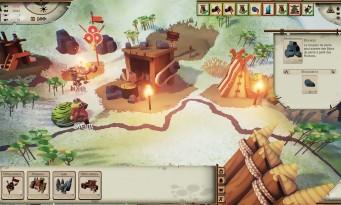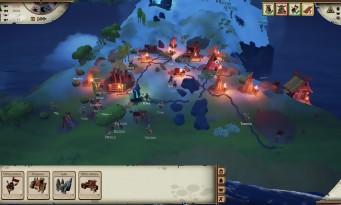 Most management games usually offer us a single-player campaign and/or a sandbox mode, which allows unlimited play on a given map. Valhalla Hills takes a third path, that of the single game, repeated at will on randomly generated maps. Concretely, each map takes the form of an island on which our Vikings (persistent from one island to another) teleport. To advance to the next map, all they have to do is go to an exit portal usually located at the other end of the island and activate it. A seemingly simple activity, but in reality requires confronting or coaxing the gate keepers. For this, it will therefore be necessary to form sufficiently powerful military units or place enough offerings on a dedicated altar. But this result requires a great deal of effort, since each time we start from scratch. It is therefore necessary to build many buildings, so that our Vikings can sleep, eat and work. We will generally start by building a toolmaker's hut, a lumberjack's hut and a sawmill, in order to facilitate the construction of the next buildings. Similarly, a quarry and a stonemason will provide bricks. The farm will give wheat, which the mill will turn into flour, which will be used by the bakery to make bread. But wheat can also be used to produce beer, as long as you have thought of digging a well somewhere, while bread will be used to create more nutritious meat or fish sandwiches in the kitchen, putting thus taking advantage of the resources of the hunter, the breeder and the fishmonger. In short, it is necessary to set up multiple production chains, as we are used to doing in the various episodes of Anno or Settlers. The learning curve of the normal mode is well proportioned, each of the first islands giving us the opportunity to discover new buildings or dangers. On the other hand, it is clearly not recommended to start in the open mode, which immediately unlocks all the features.
Most management games usually offer us a single-player campaign and/or a sandbox mode, which allows unlimited play on a given map. Valhalla Hills takes a third path, that of the single game, repeated at will on randomly generated maps. Concretely, each map takes the form of an island on which our Vikings (persistent from one island to another) teleport. To advance to the next map, all they have to do is go to an exit portal usually located at the other end of the island and activate it. A seemingly simple activity, but in reality requires confronting or coaxing the gate keepers. For this, it will therefore be necessary to form sufficiently powerful military units or place enough offerings on a dedicated altar. But this result requires a great deal of effort, since each time we start from scratch. It is therefore necessary to build many buildings, so that our Vikings can sleep, eat and work. We will generally start by building a toolmaker's hut, a lumberjack's hut and a sawmill, in order to facilitate the construction of the next buildings. Similarly, a quarry and a stonemason will provide bricks. The farm will give wheat, which the mill will turn into flour, which will be used by the bakery to make bread. But wheat can also be used to produce beer, as long as you have thought of digging a well somewhere, while bread will be used to create more nutritious meat or fish sandwiches in the kitchen, putting thus taking advantage of the resources of the hunter, the breeder and the fishmonger. In short, it is necessary to set up multiple production chains, as we are used to doing in the various episodes of Anno or Settlers. The learning curve of the normal mode is well proportioned, each of the first islands giving us the opportunity to discover new buildings or dangers. On the other hand, it is clearly not recommended to start in the open mode, which immediately unlocks all the features.
LOST VIKINGS
 Because under its appearance of a cute little game, which it is, however, Valhalla Hills conceals a fairly complete management, which takes into account multiple parameters. Just the placement of buildings can be a problem since the unevenness of the 3D terrain prevents construction in certain places, or requires the creation of expensive wooden foundations. The result is a deliciously organic placement of buildings, a far cry from the geometric housing estates of an Anno. Creating winding paths will help your vikings move faster, and care must be taken not to waste unnecessary living space, which can quickly run out. At the end of the chain, we will have enough beers and gold bars to increase the strength of our warriors or enough offerings if we choose the peaceful path. Either way, don't expect to avoid combat altogether, as the maps are inhabited by wolves, bears, and ice guardians who smash into anything within their reach.
Because under its appearance of a cute little game, which it is, however, Valhalla Hills conceals a fairly complete management, which takes into account multiple parameters. Just the placement of buildings can be a problem since the unevenness of the 3D terrain prevents construction in certain places, or requires the creation of expensive wooden foundations. The result is a deliciously organic placement of buildings, a far cry from the geometric housing estates of an Anno. Creating winding paths will help your vikings move faster, and care must be taken not to waste unnecessary living space, which can quickly run out. At the end of the chain, we will have enough beers and gold bars to increase the strength of our warriors or enough offerings if we choose the peaceful path. Either way, don't expect to avoid combat altogether, as the maps are inhabited by wolves, bears, and ice guardians who smash into anything within their reach. And that's where the game starts to show its imperfections because, since you can't direct your vikings directly (only the location of buildings, roads, and nomadic military camps), you have to trust artificial intelligence to keep your units alive. And there, we border on the drama. If you are not careful, some of your men will be chained to death, while others will flee in random directions, and just as dangerous as the initial danger, instead of returning near the village. Likewise, the transfer of goods seems to still be subject to some bugs. Even when establishing trade routes using couriers, no one seems willing to bring the necessary resources to the military camps. These being mobile, we can always bring them closer to the production lines so that the soldiers go automatically to equip themselves, but these micro-management steps are in theory not necessary. Good point on the other hand for the interface, which gives a lot of information, easily accessible and fully translated into French. Ultimately, Valhalla Hils is a frankly nice management game which, if it does not reach the mastery of the tenors of the genre, still deserves a detour on occasion.
And that's where the game starts to show its imperfections because, since you can't direct your vikings directly (only the location of buildings, roads, and nomadic military camps), you have to trust artificial intelligence to keep your units alive. And there, we border on the drama. If you are not careful, some of your men will be chained to death, while others will flee in random directions, and just as dangerous as the initial danger, instead of returning near the village. Likewise, the transfer of goods seems to still be subject to some bugs. Even when establishing trade routes using couriers, no one seems willing to bring the necessary resources to the military camps. These being mobile, we can always bring them closer to the production lines so that the soldiers go automatically to equip themselves, but these micro-management steps are in theory not necessary. Good point on the other hand for the interface, which gives a lot of information, easily accessible and fully translated into French. Ultimately, Valhalla Hils is a frankly nice management game which, if it does not reach the mastery of the tenors of the genre, still deserves a detour on occasion.


























